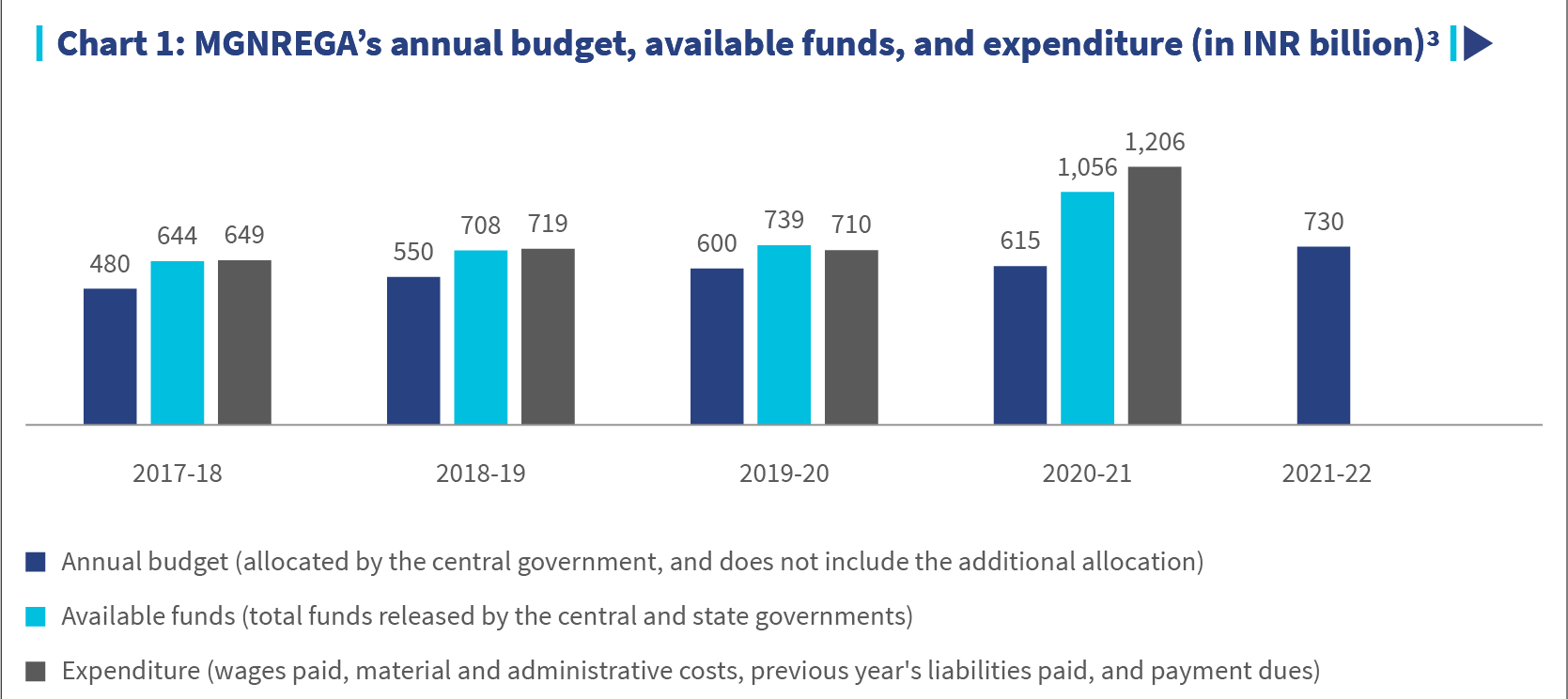MGNREGA: The delay in wage payments – Part II
by Abhishek Jain
Apr 15, 2021
7 min
Delayed wage payments and rejected transactions continue to plague the system and compromise the goals of the Mahatma Gandhi National Rural Employment Guarantee Act. The second in a two-part series, this blog examines the causes of such delays and ways to alleviate process inefficiencies in the future.
In the first part of this blog series, we looked at the genesis of the Mahatma Gandhi National Rural Employment Guarantee Act (MGNREGA), a social protection program introduced by the Government of India (GoI) in 2005 to help rural Indians achieve livelihood security. However, delayed wage payments and rejected transactions continue to plague the system and compromise the goals MGNREGA was established to achieve. In the second part of this blog series, we will look at the cause of such delays and ways to alleviate process inefficiencies going forward.
Why do delays occur?
While delays may occur at the first, second, or both stages of the payments process, payments are rejected only during Stage 2. We discus some reasons behind the delay or rejection of wage payments under MGNREGA below.
I) Delays at Stage 1: Delays at this stage occur during the generation and approval of fund transfer orders (FTOs) by field-level officials at the block and village levels. The causes for these delays may include a shortage of work officials, lack of capacity building, or the lack of computers or internet connectivity needed to generate FTOs at the block level. The Fourth Common Review Mission of the Ministry of Rural Development (MoRD) (2018) observed significant vacancies for the position of field assistant. This suggests the number of staff tasked to handle FTOs is inadequate. Additionally, some studies have also identified other administrative lapses, such as the loss or mismanagement of attendance sheets before the entry of data into the MGNREGA system, failure to generate or authorize FTOs, and the closure of work in the system without the completion of payments.
In 2015, the government introduced a Mobile Monitoring System (MMS) as a pilot project across 35,000 village councils to eliminate inefficiencies at the ground level. The pilot also sought to enable field functionaries to update the database in real-time through an MGNREGA mobile-based application. However, this system managed to achieve only limited progress. As of 16th March, 2021,[1] only 13% (34,212) of the total village councils across India are registered under MMS. Of these, only 21% (7,027) have used the system to update data. Though village councils can use this system to record the demand and allocation of work to workers and measure the works completed, they use it solely to fill attendance sheets at present. Delays at Stage 1 cause a ripple effect throughout the process, which subsequently delays the completion of the second stage within the stipulated timeframe.
II) Delays at Stage 2: Delays at this stage can be broadly examined in terms of administrative delays, shortage of funds, rejection of payment transactions, and technical errors.
- Administrative delays: These delays are attributed to the central government withholding wage payments for certain states. This is because some states fail to submit their audited fund statements for the previous year as well as utilization certificates or bank reconciliation certificates within the specified time frame. The government is yet to process around 21% and 70% of the FTO transactions generated for January and February, 2021 respectively, for wage payments. Sometimes, the government also withholds payments due to a shortage of funds allocated for various states.
- Shortage of funds: On average, approximately 20% of the funds available under MGNREGA are used annually to cover the payment liabilities of the previous year. Due to this, some states overutilize their funds and struggle with payments for the work completed in the third and fourth quarters of the financial year. This is evident by the fact that the GoI allocated an additional INR 110 billion (USD 1.5 billion[1]) above the budget of INR 600 billion (USD 8.2 billion) for MGNREGA in 2019-20.
The chart below illustrates the annual expenditure, which is higher than MGNREGA’s annual budget and availability of funds over the years.
(Source[3])
Estimates suggest that to provide 100 days of employment to all 149.9 million registered households at the national average wage of INR 202 per person per day, the GoI will need to allocate at least INR 3.03 trillion (USD 41.3 billion) annually. As per the data of 2020-21, registered households were provided with an average of 49.5 workdays.
- Rejection of payment transactions: Around 777 bank branches across India reported rejecting at least 100 transactions each in the past six months. Banks cited various reasons for the rejection, such as the absence of accounts to which payments were made, invalid accounts, and a mismatch in account description, among various others. Banks also rejected transactions if the account was closed or the participant was not mapped to the product. While rejected transactions are supposed to be regenerated for reprocessing, 5% of the rejected transactions have not been regenerated yet, which causes further delays or rejection of payments.
Of the total FTO transactions through Ne-FMS, 45% of the payments were processed through the Aadhaar Payment Bridge (APB) System. Of these, about 3% were rejected in 2020-21. The reasons include unlinked or unverified Aadhaar numbers (unique identification numbers) with the MGNREGA registration number of workers. So far, the Aadhaar numbers of only 68% of active workers have been linked, and only 77% of these have been verified.
- Technical errors: Additional delays also occur during the online processing of FTOs when some of the transaction files are lost during online transmission. Though the Ministry of Rural Development’s program division may receive some files, they cannot be processed due to errors while some others may lack digital signatures of authorizing officials.
Other than delays at various stages of the payment process, the accounting of delays by the MGNREGA server is also flawed, as highlighted in the first part of our blog series. This affects the calculation and payment of delayed compensation that workers are legally entitled to if their wage payments get delayed. While the central government and payment agencies are absolved due to this flaw, the state governments are left to bear the burden of the delayed compensation.
While the causes mentioned above shine a light on the reasons for delays or rejection of payments, a recent assessment examines the last-mile challenges workers face in accessing their wages once they have been credited into their bank or post office accounts. From the sample of 1,947 MGNREGA workers across three Indian states, about 45% of respondents had to make multiple visits to banks and 52% to post offices to withdraw their wages. Of the 249 respondents with rejected payments, 77% did not know why their payments had failed. Multiple visits to withdraw wages and get information about rejected payments lead to loss of a day’s work and wages for the workers.
The way forward
Delayed MGNREGA payments run counter to the program’s objective of providing livelihood security and social protection to millions of rural households in India. As wage rates under MGNREGA are 40% to 50% lower than minimum wages paid to unskilled agricultural workers in India, delays could further discourage workers from requesting work under the program. However, recognizing the potential of MGNREGA, GoI had allocated an additional INR 400 billion (USD 5.45 billion) above the estimated budget of INR 610 billion (USD 8.3 billion) for 2020-21. The additional budget helped provide livelihood security to the growing number of unemployed people in rural India, which saw a rise due to the COVID-19 global health pandemic and the subsequent lockdown in the country. Though the allocation of more funds is a step in the right direction, it is not sufficient to curb the growing economic distress in rural India if delays in wage payments persist.
Therefore, the following measures should be adopted or implemented to resolve issues that cause these delays:
- Investment in human resources: As highlighted in the previous section, vacancies in the administrative structure hinder the effective operations of MGNREGA. Therefore, respective state governments and district program officers should identify vacancies and employ field functionaries at the village level at the earliest. Moreover, overburdened with work, program officers like the Block Development Officer fail to approve FTOs promptly, despite the support of accountants and technicians. State governments could assign assistant program officers specifically to implement MGNREGA.
- Investment in technology: Utilizing technology can help reduce operational delays. For this, governments should actively adopt and implement the existing Mobile Monitoring System (MMS) across all village councils to keep the database updated in real-time through demand submission and work allocation, recording attendance, and measurement of work at the village level. Additionally, governments must also equip block offices with computers, printers, and internet connectivity to implement and review MGNREGA effectively through its MIS at the block level.
- Adoption of automated processes: With the adoption of MMS at the village level, governments should rethink the necessity for the current two-step process of generation and approval of FTOs at the block level. The government can automate the approval of FTOs, with the fulfillment of necessary inputs at the village level. Further, with the generation of FTOs, the wages should be credited automatically into the accounts of workers without seeking manual approvals to process FTOs at the program division of MoRD.
Additionally, field functionaries should verify and capture the details of registered households on the MMS, such as their names, registration numbers, bank account details, and Aadhaar numbers. The verification process will reduce both the cases of transaction failures and the burden of the verification process at the block level. Gradually, the government can adopt the single source of truth technology across line ministries and programs, which will allow it to automate the collection and verification processes of the details of workers.
Since MGNREGA is largely automated with a digital process of fund flow, the central government can adopt the concept of automated utilization certificates generated through the MGNREGA MIS. Meanwhile, even if state governments delay submitting the necessary financial and administrative documents, the center should not withhold wage payments.
The Ministry of Rural Development and the governments of state and union territories should collectively enforce the mandate for timely payment of wages. They should work to address delays caused by burdensome administrative, manual processes, and infrastructural gaps. Utilizing technology, capacity building, and allocation of sufficient funds can help accomplish this goal. The state and central governments, all of which share one goal, should also collaborate to ensure rural Indians receive employment as well as wages on time.
[1] The data from the MGNREGA MIS used throughout the blog is as reported on 16th March, 2021, unless specified otherwise.
[2] Conversion rate of 1 USD = INR 73.3 has been used throughout the blog (as on 3rd March, 2021)
[3] Sources: MGNREGA Financial statements as on 22nd March, 2021 – 2017-18, 2018-19, 2019-20, 2020-21; Budget – 2017-18, 2018-19, 2019-20, 2020 to 2022.
Written by

 by
by  Apr 15, 2021
Apr 15, 2021 7 min
7 min

Leave comments